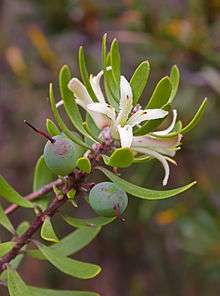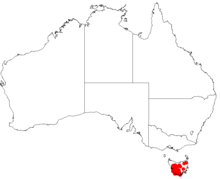Persoonia gunnii
Persoonia gunnii, commonly known as the mountain geebung, is a slow-growing shrub endemic to wet forests and subalpine shrubberies in Tasmania.[1] It forms a bush ranging from 0.6 to 3 m (2.0 to 9.8 ft) in height with short, up-curved leaves and scented cream-yellow flowers in summer giving way to small dark purple fruit. It is a common shrub in subalpine areas of the state and is occasionally confused with P. muelleri.
| Persoonia gunnii | |
|---|---|
 | |
| Scientific classification | |
| Kingdom: | Plantae |
| Clade: | Tracheophytes |
| Clade: | Angiosperms |
| Clade: | Eudicots |
| Order: | Proteales |
| Family: | Proteaceae |
| Genus: | Persoonia |
| Species: | P. gunnii |
| Binomial name | |
| Persoonia gunnii | |
 | |
| Occurrence data from Australasian Virtual Herbarium | |
Taxonomy
The English botanist Joseph Dalton Hooker described Persoonia gunnii in 1847, and it still bears its original binomial name today.[2] The genus was reviewed by Peter Weston for the Flora of Australia treatment in 1995, and the three endemic Tasmanian species P. gunnii, P. muelleri and P. moscalii are classified in the gunnii group.[3]
Populations with characteristics intermediate between P. gunnii and P. muelleri are known from Dove Lake–Cradle Mountain and Adamsons Peak–South Cape localities.[1] Further intermediates with P. muelleri subspecies angustifolia have been recorded from Adamsons Peak, the South Cape Range and the Recherche Bay area in southern Tasmania, but further work is needed to assess their status.[1]
Description
Persoonia gunnii grows as a woody shrub ranging from 0.6 to 3 m (2.0 to 9.8 ft) in height with new growth covered in whitish hair. The flat or convex narrow leaves are obovate (egg-shaped) or spathulate (spoon-shaped), and measure 1 to 5 cm (0.39 to 1.97 in) in length and 0.3 to 1 cm (0.12 to 0.39 in) across. The cream flowers are hairy on the outside and appear from December to May.[1]
Distribution and habitat
P. gunnii is found in Tasmania, specifically to the south and west of Black Bluff Range–Lake St Clair and the Derwent River from 500 to 1,300 m (1,600 to 4,300 ft) above sea level. Habitats include alpine heathland, subalpine wet sclerophyll forest and rainforest, on soils composed of and lying over dolerite, quartzite and limestone.[1]
Ecology
P. gunnii is highly sensitive to dieback.[4]
References
- "Persoonia gunnii Hook.f." Flora of Australia Online. Department of the Environment and Heritage, Australian Government.
- "Persoonia gunnii Hook.f." Australian Plant Name Index (APNI), IBIS database. Centre for Plant Biodiversity Research, Australian Government.
- Weston, Peter H. (1995). "Persoonioideae". In McCarthy, Patrick (ed.). Flora of Australia: Volume 16: Eleagnaceae, Proteaceae 1. Collingwood, Victoria: CSIRO Publishing / Australian Biological Resources Study. pp. 47–125. ISBN 0-643-05693-9.
- Rudman, Tim; Balmer, Jayne (2007). "Death on the Moor: The Impact of Phytophthora cinnamomi on Buttongrass Moorland". Australasian Plant Conservation. 16 (3): 29–31. ISSN 1039-6500.